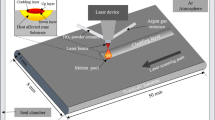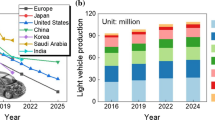Abstract
Crack propagation testing has been applied to synthetic metal matrix composites (MMC) in order to compare failure mechanisms in Ti-6Al-4V alloy reinforced by uncoated boron, B(B4C) and chemical vapour deposition (CVD) SiC filaments. The impeding effect of the fibres leads to low crack growth rates, compared to those reported for the unreinforced Ti-6Al-4V alloy and to higher toughness despite the presence of the reinforcing brittle phases. After long isothermal exposures at 850° C, the MMC crack growth resistance is reduced mainly due to fibre degradation, fibre-matrix debonding and an increase in matrix brittleness. However, for short-time isothermal exposures (up to about 10 h for B/Ti-6Al-4V, 30 h for B (B4C)/Ti-6Al-4V and 60 h for SiC/Ti-6Al-4V) the crack growth resistance is significantly increased. This improvement is related to the build up of an energy-dissipating mechanism by fibre microcracking in the vicinity of the crack tip. This damaging mechanism allowing matrix plastic deformation is already effective for boron and B(B4C) in the as-fabricated state, but occurs only after 10 h of thermal exposure at 850° C in the case of SiC/Ti-6Al-4V composites.
Similar content being viewed by others
References
J. M. Quenisset, P. Soumelidis, R. Pailler, R. Naslain andN. S. Stoloff,J. Mater. Sci. (to be published).
R. Naslain, J. Thebault andR. Pailler, Proceedings of the International Conference on Composite Materials, Geneva and Boston, April 1975, edited by E. Scala, E. Anderson, I. Toth and B. R. Noton (TMS-AIME, New York, 1975) p. 116.
P. Martineau, R. Pailler, M. Lahaye andR. Naslain,J. Mater. Sci. 19 (1984) 2749.
J. L. Pentecost, “High Temperature Inorganic Coatings” edited by J. Huminik (1963) pp. 10–45.
J. H. Westbrook andE. R. Stower, in “High Temperature Materials and Technology”, edited by Campbell and Sherwood (J. Wiley, New York, 1967) pp. 312–48.
I. E. Campbell, C. F. Powel, D. H. Nowick andB. W. Gonser,J. Electrochem. Soc. 96(5) (1949) 318.
G. V. Samsonov andA. P. Epik, “Coating of High Temperature Materials”, (Plenum Press, New York, 1966) pp. 97–106.
E. Rudy, Technical report AFML-TR. 65-2, Part. V, (1969).
M. Pigott,J. Mater. Sci. 5 (1970) 669.
A. J. Metcale andM. J. Klein, in “Composite Materials”, Vol. 1, Ch. 4, (Academic Press, New York, London, 1974) pp. 125–8.
F. W. Crossman andA. S. Yue,Met. Trans. 2 (1971) 1545.
Author information
Authors and Affiliations
Rights and permissions
About this article
Cite this article
Soumelidis, P., Quenisset, J.M., Naslain, R. et al. Effect of the filament nature on fatigue crack growth in titanium based composites reinforced by boron, B(B4C) and SiC filaments. J Mater Sci 21, 895–903 (1986). https://doi.org/10.1007/BF01117370
Received:
Accepted:
Issue Date:
DOI: https://doi.org/10.1007/BF01117370




